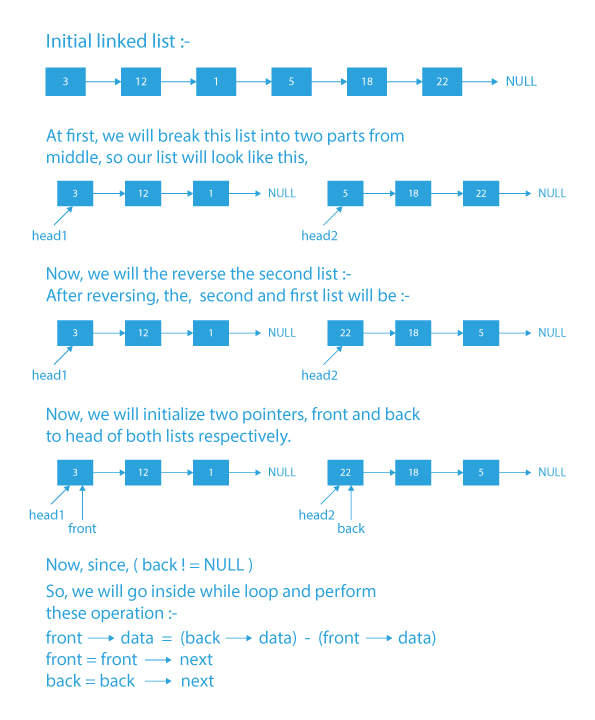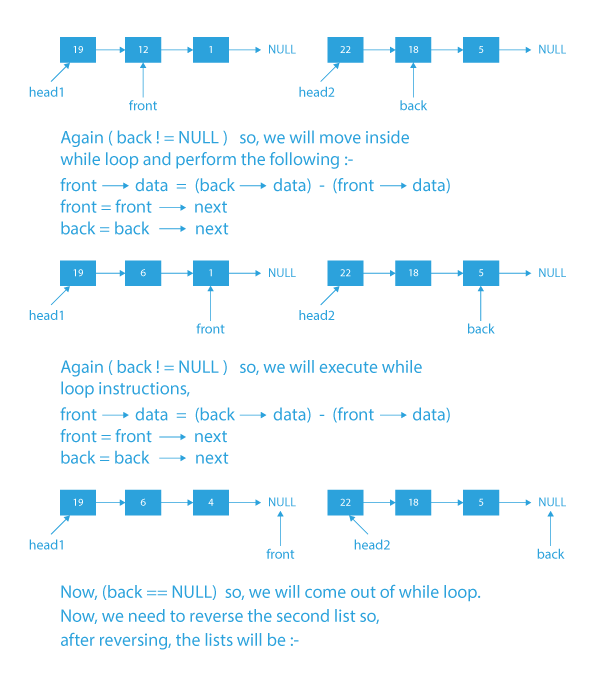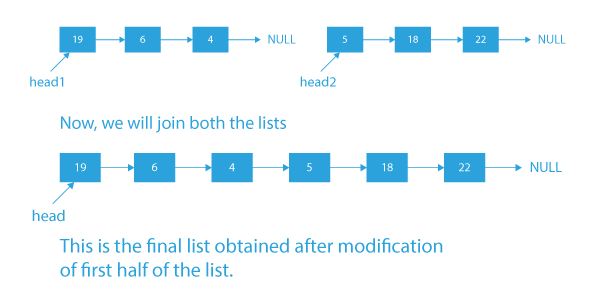In this article, we will explore various approaches to update the value of a linked list in different programming languages, such as C, C++, Java, and Python. We will cover the step-by-step implementation of update algorithms, including iterative and recursive methods. Additionally, we will address common challenges, such as updating multiple occurrences of the same value and handling edge cases like updating the first or last node.
How to update value of linked list?
To understand this problem statement, let us take examples by referring the best online programming courses.
If the given linked list is :
then according to the problem statement:
- At first, focus on the first and last node and change the value of the first node to (22 – 3) = 19.
- Then for the second node, its value will be updated to the value equal to the last-second node value minus the value of the second node, i.e., (18-12) = 6.
- Similarly, the value of the third node will be (5-1) = 4.
- So, the final linked list after modification will be:
Let us take another example:
If the linked list is 4→1→10→42→5→NULL.
- After changing the values of the first half of nodes in the fashion mentioned above, our output linked list will be 1→41→10→42→5→NULL
- Note that the number of nodes in the linked list is odd, so we will not change the middle node, i.e., node 10.
Now, I think the problem statement is clear, so let’s see how we can approach it. Any ideas? If not, it’s okay, and we will see how we can approach it in the next section.
Approach 1 to update value of linked list
- Find the first element of the second half of the linked list, i.e., find the middle node of the linked list.
- Push all elements starting from the node found above till the last of the linked list into a stack.
- Now using a temporary pointer, temp iterate the linked list starting from the head until the stack is not empty and modify temp→data by doing temp→data = (s.top() – temp→data) and then pop the element from the stack.
- Finally, when the traversal is over, we will have our final modified list as per the problem statement.
Algorithm 1 to update value of linked list
- Initialize two pointers with the head of the list and name them slow and fast.
- Find the mid-node of the list by moving the slow pointer one node at a time and the fast pointer two nodes at a time, till fast or fast →next are not NULL.
- Now once you reach the end, check whether the fast pointer is NULL or not
- If it is NULL then the number of nodes in the list is even, then no need to update the slow pointer as it will point to the first element of the second half of the list.
- If it is not NULL that means the number of nodes in the list is odd so, to point to the first element of the second half of the list, we need to move the slow pointer by one node.
- Now, we have the starting point of the second half of the list so, we will start iterating the list from here and push all data of nodes in the stack till the end of the list.
- Now, we will begin an iteration from the starting of the list and change the value of each node to the difference of the stack’s top element and the current node at which we are in the iteration, and then we will pop the element from the stack.
- We will repeat the above step till the stack is not empty.
We will get our desired list by following the above steps.
**Time complexity:** O(n) is the time complexity for the Linked list value update, Where n is the number of nodes in the list.
**Space Complexity:** O(n) is the time complexity for the Linked list value update, Where n is the number of nodes in the list.
As you can see that in the above approach, we used an extra space of O(n) because we were pushing the elements of the second half of the list in the stack.
Can we improve this to constant extra space?
- The answer is yes, we can improve our algorithm, refer below to get an idea of the constant extra space approach.
Helpful Observations
- Notice that we cannot move backward in a linked list, so we need to devise a way by which we can traverse the list in forward and backward directions.
- This can be only done if we first break the list from the middle into two parts and then reverse the second half.
- After doing this, we can treat each half as two different lists, and moving forward in the second half of the list would eventually mean to iterate in the list in the backward direction as it is reversed.
- Then, we can keep one pointer at the starting of each half, modify the nodes’ values that belong to the first half, and advance each pointer to the next node.
Let’s see another approach on How to update value of linked list.
Approach 2 to update value of linked list
Our approach will be simple:
- Find the middle node of the linked list and then split the linked list from the middle with the help of a fast and a slow pointer, where the slow will move one node at a time and the fast one will move 2 nodes at a time, so that when fast will be at the end of the list slow will be at the middle.
- Now, reverse the second half of the list obtained in the above step.
- Initialize two pointers named front and back with the starting of each list, respectively.
- Iterate over both the lists simultaneously and update the values of the first half nodes as directed in the problem statement.
- Then again, reverse the second half of the list.
- Then join the two parts (first half and second half) of the list as they were originally given to us.
Algorithm 2 to update value of linked list
- At first, we will find the middle node of our linked list and then break the list from there.
- Then, we will have two different linked lists.
- Then, we will reverse the second linked list.
- Initialize two pointers, front and back, where the front will point to the first node of the first list and the back will point to the first node of the second list.
- While the end of the second list is not reached i.e., back is not equal to NULL pointer, we need to iterate the list and do the following:
a) Change front’s data to the difference of back’s and front’s data (front->data = back->data – front->data).
b) Advance front pointer by one node (front = front->next).
c) Advance back pointer by one node (front = front->next). - After the while loop ends, reverse the second list again.
- Now, attach the second list to the end of the first list.
- Return the head of the newly created list.
- The first half nodes of the returned list will be modified according to the problem statement.
Dry Run of update value of linked list
Code Implementation
#includeusing namespace std; class Node { public: int data; Node* next; Node(int x){ data = x; next = NULL; } }; void midPartition(Node *head, Node **front_ref, Node **back_ref) { Node *slow, *fast; slow = head; fast = head->next; /* Advance 'fast' pointer two nodes at a time and advance 'slow' pointer one node at a time */ while (fast != NULL) { fast = fast->next; if (fast != NULL) { slow = slow->next; fast = fast->next; } } /* 'slow' is before the midpoint in the list, so split it in two at that point. */ *front_ref = head; *back_ref = slow->next; slow->next = NULL; } void reverseList(Node **head_ref) { Node *current, *prev, *next; current = *head_ref; prev = NULL; while (current != NULL) { next = current->next; current->next = prev; prev = current; current = next; } *head_ref = prev; } void modifyContent(Node *head1,Node *head2) { Node *front = head1, *back = head2; // traverse both the lists simultaneously while (back != NULL) { front->data = back->data - front->data; front = front->next; back = back->next; } } void printList(Node *head) { if (!head) return; while (head->next != NULL) { cout << head->data << " "; head = head->next; } cout << head->data << endl; } Node* concatFrontAndBackList(Node *front, Node *back) { Node *head = front; while (front->next != NULL) front = front->next; front->next = back; return head; } Node* solve(Node *head) { // if list is empty or contains only single node then return it if (!head || head->next == NULL) return head; Node *front, *back; // split the list into two parts midPartition(head, &front, &back); // reverse the 2nd half of the list reverseList(&back); // modify the contents of 1st half of the list modifyContent(front, back); // again reverse the 2nd half of list reverseList(&back); // concatenate both the halves to get the original list // that was provided initially head = concatFrontAndBackList(front, back); // pointer to the modified list return head; } int main(void) { Node* head = NULL; head = new Node(3); head->next = new Node(12); head->next->next = new Node(1); head->next->next->next = new Node(5); head->next->next->next->next = new Node(18); head->next->next->next->next->next = new Node(22); Node *tmp = solve(head); printList(tmp); return 0; }
#include#include #include struct Node { int data; struct Node* prev; struct Node* next; }; void push(struct Node** head_ref, int new_c) { struct Node* new_node = (struct Node*) malloc(sizeof(struct Node)); new_node->data = new_c; new_node->prev = NULL; new_node->next = (*head_ref); if ((*head_ref) != NULL) (*head_ref)->prev = new_node; *head_ref = new_node; } bool isCircular(struct Node *head){ struct Node *temp=head; while(temp!=NULL) { //if temp points to head then it has completed a circle,thus a circular linked list. if(temp->next==head) return true; temp=temp->next; } return false; } int main(void) { struct Node* head = NULL; push(&head, 5); push(&head, 4); push(&head, 3); push(&head, 2); push(&head, 1); if(isCircular(head)) printf("Yes\n"); else printf("No\n"); }
class Modify
{
static class Node
{
int data;
Node next;
};
static Node push(Node head_ref, int new_data)
{
Node new_node =new Node();
new_node.data = new_data;
new_node.next = head_ref;
head_ref = new_node;
return head_ref;
}
static Node front,back;
/* Split the nodes of the given list into front and back halves,
and return the two lists using the reference parameters.
Uses the fast/slow pointer strategy. */
static void frontAndBackSplit( Node head)
{
Node slow, fast;
slow = head;
fast = head.next;
/* Advance 'fast' two nodes, and
advance 'slow' one node */
while (fast != null)
{
fast = fast.next;
if (fast != null)
{
slow = slow.next;
fast = fast.next;
}
}
/* 'slow' is before the midpoint in the list,
so split it in two at that point. */
front = head;
back = slow.next;
slow.next = null;
}
/* Function to reverse the linked list */
static Node reverseList( Node head_ref)
{
Node current, prev, next;
current = head_ref;
prev = null;
while (current != null)
{
next = current.next;
current.next = prev;
prev = current;
current = next;
}
head_ref = prev;
return head_ref;
}
// perform the required subtraction operation on the 1st half of the linked list
static void modifyTheContentsOf1stHalf()
{
Node front1 = front, back1 = back;
// traversing both the lists simultaneously
while (back1 != null)
{
// subtraction operation and node data modification
front1.data = front1.data - back1.data;
front1 = front1.next;
back1 = back1.next;
}
}
// function to concatenate the 2nd(back) list
// at the end of the 1st(front) list and
// returns the head of the new list
static Node concatFrontAndBackList(Node front,Node back)
{
Node head = front;
if(front == null)return back;
while (front.next != null)
front = front.next;
front.next = back;
return head;
}
// function to modify the contents of the linked list
static Node modifyTheList( Node head)
{
// if list is empty or contains only single node
if (head == null || head.next == null)
return head;
front = null; back = null;
// split the list into two halves front and back lists
frontAndBackSplit(head);
back = reverseList(back);
// modify the contents of 1st half
modifyTheContentsOf1stHalf();
// agains reverse the 2nd(back) list
back = reverseList(back);
head = concatFrontAndBackList(front, back);
return head;
}
static void printList( Node head)
{
if (head == null)
return;
while (head.next != null)
{
System.out.print(head.data + " -> ");
head = head.next;
}
System.out.println(head.data );
}
// Driver Code
public static void main(String args[])
{
Node head = null;
// creating the linked list
head = push(head, 10);
head = push(head, 7);
head = push(head, 12);
head = push(head, 8);
head = push(head, 9);
head = push(head, 2);
// modify the linked list
head = modifyTheList(head);
// print the modified linked list
System.out.println( "Modified List:" );
printList(head);
}
}
// This code is contributed by Arnab Kundu
class Node: def __init__(self, data): self.data = data self.next = None def push(head_ref, new_data): new_node =Node(0) new_node.data = new_data new_node.next = head_ref head_ref = new_node return head_ref front = None back = None def frontAndBackSplit( head): global front global back slow = None fast = None slow = head fast = head.next while (fast != None): fast = fast.next if (fast != None): slow = slow.next fast = fast.next front = head back = slow.next slow.next = None return head def reverseList( head_ref): current = None prev = None next = None current = head_ref prev = None while (current != None): next = current.next current.next = prev prev = current current = next head_ref = prev return head_ref def modifyTheContentsOf1stHalf(): global front global back front1 = front back1 = back while (back1 != None): front1.data = (back1.data - front1.data) front1 = front1.next back1 = back1.next def concatFrontAndBackList( front, back): head = front if(front == None): return back while (front.next != None): front = front.next front.next = back return head def modifyTheList( head): global front global back if (head == None or head.next == None): return head front = None back = None frontAndBackSplit(head) back = reverseList(back) modifyTheContentsOf1stHalf() back = reverseList(back) head = concatFrontAndBackList(front, back) return head def printList( head): if (head == None): return while (head.next != None): print(head.data ,end=" ") head = head.next print(head.data ) head = None head = push(head, 22) head = push(head, 18) head = push(head, 5) head = push(head, 1) head = push(head, 12) head = push(head, 3) head = modifyTheList(head) printList(head)
Output
19 6 4 5 18 22
Time complexity: O(n), Where n is the number of nodes in the list.
Conclusion
So, in this blog, we have tried to write down the steps to modify a node in linked list in the most optimal way. We hope this article will enhance your knowledge. If you want to solve more questions on Linked List, which are curated by our expert mentors at PrepBytes, you can follow this link Linked List.
## FAQ for update value of linked list
**1. Can I update values in a linked list without traversing the entire list?**
In most cases, updating a value in a linked list requires traversing the list until the target node is found. However, if you have additional data structures, such as hash tables or indexes, you may perform updates more efficiently by directly accessing the target node.
**2. How do I handle updating values in a sorted linked list?**
Updating values in a sorted linked list requires maintaining the sorted order after the update. You can either remove and re-insert the node with the updated value or directly modify the node’s value while keeping the list sorted.
**3. What are the best practices for updating multiple occurrences of a value in a linked list?**
To update multiple occurrences of a value, you need to traverse the entire list and update each matching node accordingly. Ensure you correctly update all instances of the value to avoid any inconsistencies in the linked list.
**4. How do I handle updating the value of the first or last node in a linked list?**
Updating the first node involves updating the head pointer to point to the new value. For updating the last node, you may need to traverse the list until the last node is reached and then update its value.
**5. Can updating values in a linked list result in memory leaks or data corruption?**
Updating values in a linked list should be done with caution to avoid memory leaks and data corruption. Always properly manage memory allocation and deallocation, and ensure that pointers are correctly updated to maintain the integrity of the linked list.








